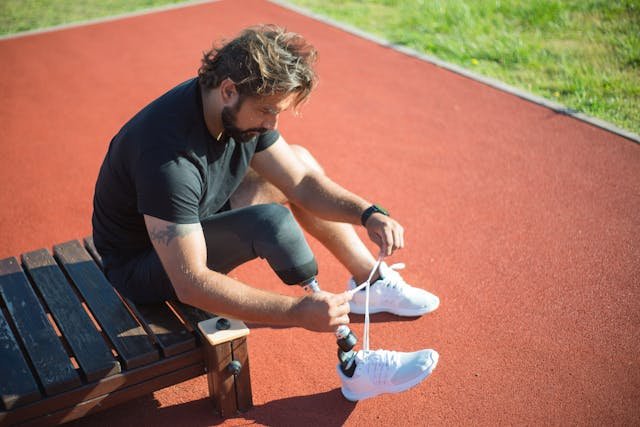When it comes to using a prosthetic leg, every step matters—literally. One of the most important factors that affects how comfortable, confident, and independent a person feels is how much energy they use while walking. This is what we mean by energy efficiency. The more efficient the prosthetic, the less effort it takes to move, and the easier life becomes.
For people using lower-limb prosthetics, especially transtibial (below-knee) and transfemoral (above-knee) prosthetics, the energy needed to walk or perform daily tasks can be very different. At Robobionics, we’ve supported hundreds of individuals at different stages of recovery and mobility. We’ve seen how choosing the right prosthetic setup can make all the difference in energy use and overall comfort. This article takes a close look at how energy efficiency varies between transtibial and transfemoral prosthetics, and what you can do to make movement easier and more natural.
Understanding Energy Efficiency in Prosthetics
Before diving into comparisons, it’s important to understand what energy efficiency means in this context. It’s not just about how fast someone can walk—it’s about how much effort the body needs to use for every movement.
What Happens When You Walk with a Prosthetic
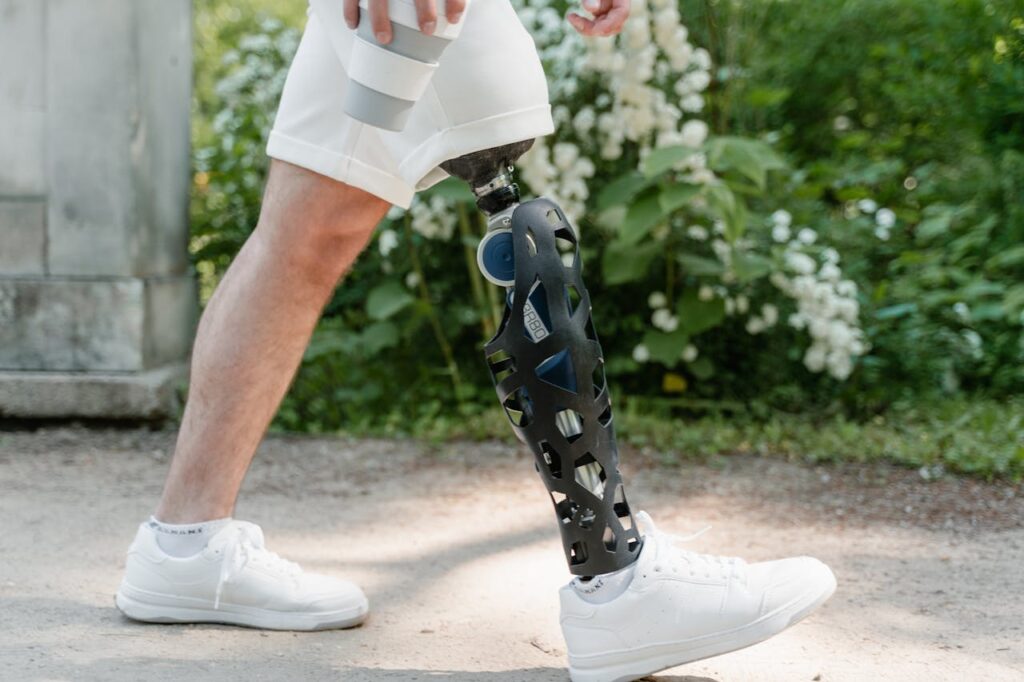
Walking with a prosthetic involves more than just stepping forward. Every movement—from lifting the foot to shifting weight to keeping balance—requires the body to work in a new way. Muscles, joints, and even breathing patterns all play a role in helping a person move safely and smoothly.
With a natural leg, the knee and ankle help absorb shock, push the body forward, and balance every step. When someone uses a prosthetic, some of this work is passed on to other parts of the body. This changes the walking pattern and increases the energy needed to walk, especially if the prosthetic doesn’t match the person’s body well.
The goal of any good prosthetic is to reduce that extra effort. The more the prosthesis works with the body instead of against it, the less energy the person uses—and the easier it is to stay active through the day.
Why Energy Efficiency Is So Important
For many users, walking isn’t just about mobility—it’s about freedom. But when walking takes too much effort, it can lead to fatigue, back pain, joint issues, and even a loss of motivation to stay active. This is why energy efficiency is such an important part of prosthetic design and fitting.
Transtibial and transfemoral prosthetics require different amounts of effort. The more joints and muscles that are missing, the more the body needs to compensate. That means someone with an above-knee amputation may use more energy than someone with a below-knee amputation, even if they are the same age, size, and fitness level.
Improving energy efficiency allows users to walk longer, move more freely, and get through the day with less exhaustion. At Robobionics, our goal is to help users feel strong and comfortable—not just for a few steps, but throughout all the moments that matter.
Measuring and Improving Efficiency
While there are scientific ways to measure energy use—like tracking oxygen levels or heart rate—most users can feel energy efficiency in their daily life. If walking feels smooth, balanced, and not tiring, that’s a good sign. If it feels slow, painful, or draining, something may need to change.
Efficiency can be improved through many ways: better socket fit, lighter components, energy-return feet, and knee joints that match the user’s strength and walking speed. But perhaps most important is training. The right movement techniques and strengthening exercises can reduce strain and improve how energy flows through the body.
We work closely with each user to find where energy is being lost and how to fix it. Small changes can lead to big improvements when it comes to energy and comfort.
Energy Use in Transtibial Prosthetics
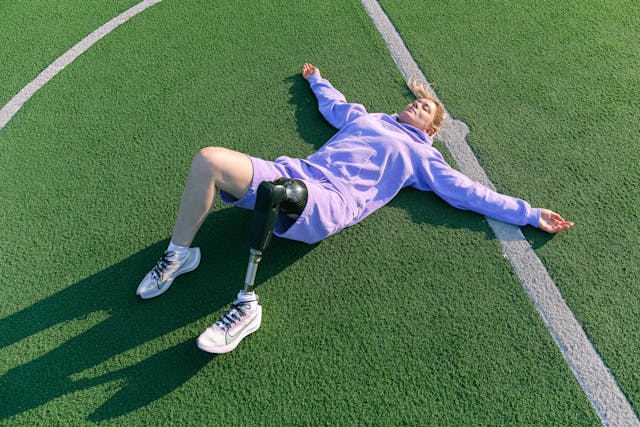
Transtibial prosthetics, which are used after a below-knee amputation, tend to be more energy-efficient than above-knee prosthetics. That’s because the knee joint is still present, and the user can rely on their natural leg for many movements.
The Role of the Natural Knee in Saving Energy
Having a functioning knee makes a big difference in how energy moves through the body. The knee helps absorb impact during walking, allowing the body to stay aligned and balanced. It also plays a key role in lifting the foot and pushing the body forward during each step.
For transtibial users, the prosthetic replaces only the foot and part of the lower leg. Because the rest of the leg is intact, the user has better control over movement and requires less muscle compensation from the hips, back, or arms.
This natural movement pattern helps reduce overall energy use. Walking feels smoother, and users can move longer without feeling tired. It also means less strain on the rest of the body, which leads to better long-term comfort and fewer secondary problems.
How Socket Fit and Foot Design Affect Efficiency
Even with a below-knee prosthetic, energy use can rise quickly if the socket doesn’t fit well. If the socket is too tight, it can cause pain. If it’s too loose, it allows movement inside the prosthetic, leading to instability and wasted effort.
The design of the foot is also important. Energy-return feet, made with lightweight and flexible materials, store energy when the foot hits the ground and return it when the user pushes off. This makes walking feel more natural and requires less effort to maintain speed.
At Robobionics, we customize each transtibial prosthetic to fit the user’s limb shape, weight, and activity level. We also guide them in choosing the right foot that matches their walking goals. When the setup is correct, the result is a more efficient and enjoyable walking experience.
Rehabilitation for Better Movement
Even with the best prosthetic, the body needs to learn how to move again. For transtibial users, this training often focuses on balance, step timing, and using the full foot while walking. These skills help reduce any limping or uneven gait, which saves energy in the long run.
Exercises to strengthen the thigh, hip, and core muscles are also important. These muscles support the leg during walking and help prevent fatigue. By learning to shift weight correctly and maintain proper posture, users can walk longer without feeling worn out.
Robobionics offers gamified home-based rehab to make this training easier and more engaging. These sessions are designed to help users build strength and coordination, which directly improves energy efficiency.
Energy Use in Transfemoral Prosthetics
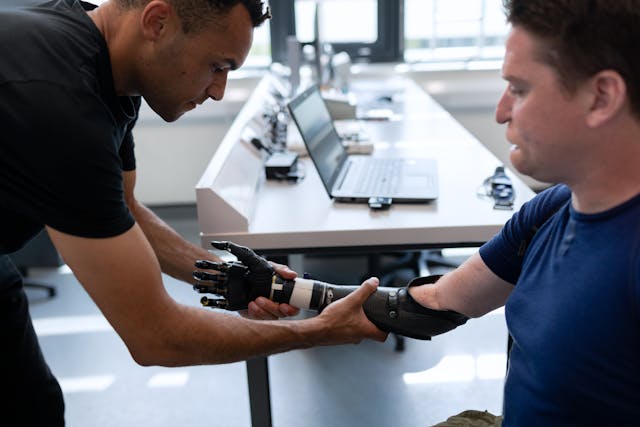
Transfemoral prosthetics, which are used after an above-knee amputation, generally require more energy to use. That’s because the person is missing both the knee and the lower leg, and the body has to work harder to compensate for those missing joints.
How the Missing Knee Affects Energy
Without a natural knee, the body needs to rely on a mechanical or electronic knee joint to support standing, bending, and walking. This changes the way energy flows through each step. Instead of bending the knee naturally, the user must use their hips and upper body to swing the leg forward.
This movement requires more energy and more muscle coordination. It can also affect the balance of the whole body. For example, the user may lean to one side to help the leg clear the ground or lift the hip higher than normal while walking.
These small changes may not seem like much at first, but over time, they lead to fatigue, joint pain, and increased effort. A well-designed prosthetic knee can help reduce this extra work and restore some of the natural movement lost with the amputation.
The Impact of Knee Joint Technology
The type of knee joint used in a transfemoral prosthetic can greatly affect how much energy is used. Basic mechanical knees may provide simple bending, but they don’t adjust to walking speed or surface changes. This puts more pressure on the user to stay balanced and maintain control.
More advanced knees, like microprocessor-controlled joints, use sensors and computers to adjust movement in real-time. These knees lock when needed for stability and unlock to allow smoother bending. They support a more natural walking pattern and help reduce energy loss.
While these advanced knees may cost more, they offer a big benefit in terms of comfort and efficiency. At Robobionics, we help users compare options based on their lifestyle, strength, and budget so they can find a knee that gives them the best results without unnecessary strain.
Training the Body to Move Smarter
Transfemoral users need a different kind of training to improve efficiency. Since the hip takes over many of the movements the knee used to handle, strengthening the hip and core muscles is essential. Training focuses on timing, balance, and reducing extra body movement.
Users are also taught techniques like “hip hiking” and “step-through gait” to make walking smoother and more energy-saving. These small changes in walking style help reduce the physical effort needed for each step.
With regular training and proper prosthetic alignment, even transfemoral users can achieve a steady, confident walk. It takes time and patience, but with the right setup and support, energy efficiency becomes possible—even with the added challenge of an above-knee amputation.
Comparing Energy Use: Transtibial vs. Transfemoral
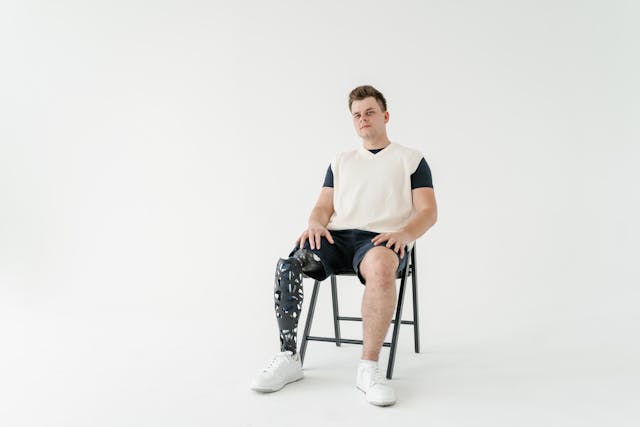
Now that we’ve looked at both types separately, it’s clear that there are differences in how much energy is used. But it’s also important to understand why those differences exist, and how they affect real-life movement.
Overall Energy Demands
In general, people with transfemoral prosthetics use more energy to walk than people with transtibial prosthetics. Research shows that above-knee amputees may use up to 60 percent more energy than people without an amputation. Transtibial users typically use around 20 to 40 percent more energy, depending on fit and training.
This difference comes from the loss of the knee joint, which is a key player in smooth, efficient walking. Without it, the body has to work harder to stay upright and move forward. This doesn’t mean one group is better than the other—it just means transfemoral users need more support and more careful design to manage energy.
At Robobionics, we address this from day one. We explain the extra energy needs and provide tools and training to help every user walk as easily and naturally as possible.
Factors That Change the Equation
Energy efficiency isn’t fixed. It can improve or decline based on many things: the shape of the residual limb, the condition of the muscles, the weight of the prosthesis, the surface you’re walking on, and how well the components are aligned.
For both transtibial and transfemoral users, small changes in any of these areas can lead to big differences in how the body feels at the end of the day. That’s why regular follow-up, re-fitting, and rehabilitation are so important.
We also remind users that mindset matters. Confidence, consistency in training, and motivation all support better movement. When someone believes in their ability and feels supported by their prosthesis, they often move more efficiently—regardless of amputation level.
Choosing the Right Setup for Your Needs

Whether you’re using a transtibial or transfemoral prosthesis, your setup should work with your body—not just in the clinic, but in your real life. This means choosing components that fit your activity level, training regularly, and checking in with your prosthetist whenever something feels off.
There’s no single best answer for everyone. Some people thrive with simple mechanical parts and strong rehab. Others may need advanced components to match their goals. What matters most is having a system that helps you conserve energy, move comfortably, and stay active through the day.
Robobionics offers personalized fittings, real-world testing, and home-based support to help you find and maintain that balance.
How Robobionics Improves Energy Efficiency for Every User
Creating a prosthetic that supports energy-efficient movement is not just about using the latest parts—it’s about understanding the person behind the limb. At Robobionics, we take a full-body, full-life approach to improving energy efficiency for both transtibial and transfemoral users. From design to rehabilitation, every step is planned with your energy, comfort, and confidence in mind.
Custom Design Focused on Real-Life Comfort
One of the biggest reasons users feel tired while walking is because their prosthetic doesn’t fit right. Even small gaps, pressure points, or misalignment can cause the body to work harder than it should. That’s why we focus on custom-made sockets that are crafted to match your limb exactly.
We use digital scanning and careful measurement to build sockets that hold the limb firmly but gently. The more secure and even the pressure, the better the limb moves inside the socket. This reduces the risk of rubbing, pistoning, or loss of control, all of which waste energy.
We also pay attention to materials. Our sockets are built with lightweight, breathable components that reduce heat and discomfort. This allows users to wear their prosthetic longer, walk farther, and feel less fatigue throughout the day.
Matching Technology to the Person—not the Price Tag

We know that not everyone needs—or can afford—the most advanced prosthetic parts. But that doesn’t mean energy efficiency should be out of reach. At Robobionics, we believe that the best prosthetic is the one that matches your goals, your strength, and your lifestyle.
We take the time to understand your daily routine. Are you mostly at home or do you travel every day? Do you walk long distances or spend most of your time seated? Based on these details, we recommend components that support smoother movement without overcomplicating things.
For transtibial users, we offer energy-return feet that make walking feel lighter and more responsive. For transfemoral users, we provide a full range of knee joints—from stable mechanical options to smart microprocessor knees that adjust automatically. Whatever your situation, our goal is to help you move smarter, not harder.
Ongoing Support and Gamified Rehabilitation
A good prosthetic isn’t enough on its own. The way you use it—and the training you follow—makes just as much of a difference in your energy efficiency. That’s why we offer structured rehab programs designed to build strength, improve walking patterns, and boost long-term comfort.
Our gamified home-based rehabilitation tools turn therapy into a motivating, interactive experience. You get to practice important movements while tracking your progress in real time. These exercises are designed to build the muscles that support efficient walking, reduce bad habits, and increase confidence with every session.
We also provide regular follow-ups and adjustment sessions. If your limb changes shape, your walking pattern shifts, or your goals evolve, we make sure your prosthetic evolves with you. That’s how we help you stay efficient—not just today, but in the months and years to come.
Conclusion
Energy efficiency is not just a technical term—it’s the key to living better with a prosthetic. Whether you use a transtibial or transfemoral prosthesis, your energy levels affect how you move, how long you walk, and how much you enjoy daily life.
Transtibial users often benefit from a more natural gait and lower energy demands, thanks to their preserved knee joint. Transfemoral users face more challenges but can reach excellent mobility with the right knee joint, smart training, and a prosthesis that matches their body.
At Robobionics, we believe every user deserves to move with ease. That’s why we offer high-quality, lightweight, and ergonomic prosthetics built right here in India—with full support, custom fittings, and advanced rehab tools.
Book a free demo or consultation today and discover how Robobionics can help you walk farther, longer, and stronger—with less effort, and more freedom.



